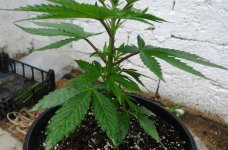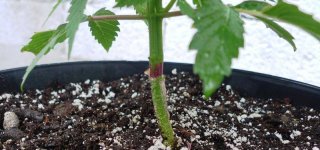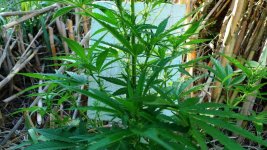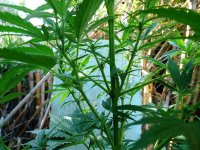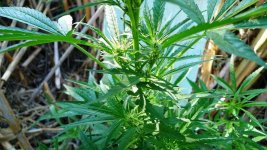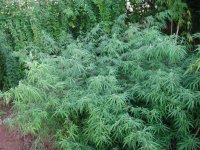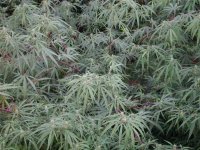You are using an out of date browser. It may not display this or other websites correctly.
You should upgrade or use an alternative browser.
You should upgrade or use an alternative browser.
Nepal Jam
- Thread starter Ganico
- Start date
Haze Demon
New member
Haze Demon
New member
Beautiful start ThaiBliss
I can feel all the effort and time that you invested to prepare the soil, very good job!
It's a very good idea to cross Bangi Haze with Nepal Jam (or viceversa). Both strains are fast flowering inbred sativa dominant hybrids, the outcome of the cross will be almost like an F1 and you will be able to easily find vigorous and better yielding expressions.
Wish the outdoor season comes good for you and we can enjoy with your updates during their development and in late flowering.
Thanks for the encouragement Dubi.
I did have a little bit of an issue with the soil. Too much compost. I had to add calcium carbonate to raise the PH. I think I also damaged the roots in the transplant of this one.
NepalJam on Transplant Day:
NepalJam Two Weeks Later:
It finally recovered:
The Bangi Haze looked bad for a while also, but not nearly as bad as that one. They are racing along, and are head high.
This is my favorite skinny leaf one with the light color and spicy smell:
ThaiBliss
Thanks for the encouragement Dubi.
I did have a little bit of an issue with the soil. Too much compost. I had to add calcium carbonate to raise the PH. I think I also damaged the roots in the transplant of this one.
NepalJam on Transplant Day:
View Image
NepalJam Two Weeks Later:
View Image
It finally recovered:
View Image
View Image
The Bangi Haze looked bad for a while also, but not nearly as bad as that one. They are racing along, and are head high.
This is my favorite skinny leaf one with the light color and spicy smell:
View Image
ThaiBliss
Hmm. My NepJam don't look anything like those. Mine all have very indica-looking traits. Short internode length and very broad fat leaves at 25 days of veg. Lots (lots) of pheno variation among individuals suggesting a rather unstable F1 hybrid, but all look classically indica. I mean like Afghani. Germination rate was stellar, and the health of the plants is great. But a cross of two pure sativas, backcrossed (which should help stabilize the hybrid)? Hmm. I don't think so. We'll see. I think I'm looking at an unstable indica cross to tell you the truth. I've done dozens of grows, and I know that sativa leaves get thinner over the life of the plant. But these are indica-looking plants. Very. That certainly would explain the reported 9 week flowering time.
I'll withhold judgment until the end of flowering and report back. But I don't think I have a pure sativa cross in the NepJam seeds I bought from Ace. At this point, the plants look more like unknown indica bag seed plants than high value/high cost breeder efforts.
Last edited:
Aquaponicos
Member
I have a question...Those that have grown out male NepaleseJamm are they JBM dominant?
The high is intensely motivational.
The high is intensely motivational.
Hmm. My NepJam don't look anything like those. Mine all have very indica-looking traits. Short internode length and very broad fat leaves at 25 days of veg. Lots (lots) of pheno variation among individuals suggesting a rather unstable F1 hybrid, but all look classically indica. I mean like Afghani. Germination rate was stellar, and the health of the plants is great. But a cross of two pure sativas, backcrossed (which should help stabilize the hybrid)? Hmm. I don't think so. We'll see. I think I'm looking at an unstable indica cross to tell you the truth. I've done dozens of grows, and I know that sativa leaves get thinner over the life of the plant. But these are indica-looking plants. Very. That certainly would explain the reported 9 week flowering time.
I'll withhold judgment until the end of flowering and report back. But I don't think I have a pure sativa cross in the NepJam seeds I bought from Ace. At this point, the plants look more like unknown indica bag seed plants than high value/high cost breeder efforts.
Komboloi,
I don't really know the precise definition of Indica versus Sativa. I'm not sure I believe it can be precisely defined. All I know is that I have come to develop a strong aversion to couch-lock type effects.
My other NepaleseJam looked very much like most of my Bangi Haze. If not for labeling, I would have lost track of which was which. It turned out to be male, so I have cut it way back in reserve for seed making.
My First three Bangi Haze were also very fat leaf classic Indica looking seedlings. The leaves did get thinner at maturity. When the Bangi Haze were young, I was so disappointed and actually asked Dubi to send me something else or I wanted my money back. He said not to worry, the effect is very Sativa like. I grudgingly carried on, and I'm so glad I did. Not only did it have a Sativa like high, it was extremely high quality Sativa effect. They are very energetic, without being nervous, and euphoric. They are also productive indoors. I had so much, I made hash. You should see the big smiles on people's faces when they try it. They don't even have to tell me how they like it. It is totally obvious by the looks on their faces.
The good news is that I believe I have tried a Jamaican strain that is the same or very similar to the Jamaican in NepaleseJam. It is good and happy also. Positive vibe, and with a bit of a floaty feeling. Just don't let it get too ripe. I found that it gets a little dull and down when overripe. This advice is only good if I am correct about the Jamaican lineage. I have not tried NepaleseJam yet.
As long as the effect breeds true, then I don't mind if there are various physical manifestation that express themselves in the seed stock. In fact, IMHO, it is probably a sign of good breeding that there is enough variation to keep the line healthy. After all, I'm not growing these things for ornamentals. I'm looking for the effect.
Here are a couple of my first Bangi Haze:
The one that turned out to be female, from these above, got thinner leaves and stretched quite a bit:
But it did put on the beef like an Indica Sativa cross:
Can you tell that I love these Nepalese genetics? I did go through what you are going through now, but I have come to be an admirer of the work that Dubi and Charlie Garcia have done with these lines.
Here is one of the fatter leaved outdoor Bangis that looked just like the other NeplaleseJam that I cut back:
Bottom line is that I believe I have a Jamaican leaning NeplaleseJam female that is pictured in my previous post, but I'm very confident in the worthiness of the fat leaved male that I am keeping for pollination. If anything, I'm more confident of the Nepalese leaning plant. I look forward to finding out.
Please keep us informed how you wind up liking it when you give it the true test.
Best of Luck,
ThaiBliss
S
scai
Hmm. My NepJam don't look anything like those. Mine all have very indica-looking traits. Short internode length and very broad fat leaves at 25 days of veg. Lots (lots) of pheno variation among individuals suggesting a rather unstable F1 hybrid, but all look classically indica. I mean like Afghani. Germination rate was stellar, and the health of the plants is great. But a cross of two pure sativas, backcrossed (which should help stabilize the hybrid)? Hmm. I don't think so. We'll see. I think I'm looking at an unstable indica cross to tell you the truth. I've done dozens of grows, and I know that sativa leaves get thinner over the life of the plant. But these are indica-looking plants. Very. That certainly would explain the reported 9 week flowering time.
I'll withhold judgment until the end of flowering and report back. But I don't think I have a pure sativa cross in the NepJam seeds I bought from Ace. At this point, the plants look more like unknown indica bag seed plants than high value/high cost breeder efforts.
Nepal is not that far from Afgan
I have always thought that when you have a plant that has indica and sativa in its genes the outcome is 50-25-25.This is what wiser people say. I mean if it's 1-1 and not polyhybrid.
You can have 50 % mixed genes, 25% that come out like sativa and the rest 25% indicaleaning.
So it's not a suprise that in even in 25 % indicas, you have less indica and more indica leaning phenos?
I bet yours is very much indica and has fat leaves.It still has sativa efect in it's flowers like ThaiBliss said.
So don't cut her, grow big and see what you got?
You might be pleasantly surprised
Cos I say, Ace gives no bad seed whatsoever.
love scai
I'd rather stand by komboloi's side since I have got three Nepjams going and them being three different phenos.
The first has got medium broad leaves and bushy structure
the second has got the same leaves but columnar structure
and the third one is shown in an above post and it's the only one with red stem and stalks
All three have got short internodes
As a bottom note I have no experience whatsoever with such strains...
Orfeas
The first has got medium broad leaves and bushy structure
the second has got the same leaves but columnar structure
and the third one is shown in an above post and it's the only one with red stem and stalks
All three have got short internodes
As a bottom note I have no experience whatsoever with such strains...
Orfeas
Thank you, ThaiBliss, scai, and orfeas. I will grow these plants out to maturity and let you know my experience. I'm going to give them 40 days of veg before flowering (they are at day 26 now), so they will have plenty of time to express themselves. They are growing in a simple passive hydro set up that I've used many times with success, so this will be a good test. As always, I'll be chucking pollen (best female gets to make whoopy with the best male), because I like having lots of seeds of different varieties.
Orfeas: I also have some purple leaf-stems like yours above. In my experience with other strains, that effect comes and goes with maturity and climatic conditions. It will be interesting to see if the NepJam is any different.
Orfeas: I also have some purple leaf-stems like yours above. In my experience with other strains, that effect comes and goes with maturity and climatic conditions. It will be interesting to see if the NepJam is any different.
We have to remember to have an open mind in regard to expression toward different varieties. Classification is changing in definition. All cannabis Sativa L. is hemp. All cannabis Indica is drug class cannabis. This latter sub set is then divided into two. NLD (narrow leaf drug) and WLD (wide leaf drug).
In regards to Nepalese, Northern Indian, Kashmiri genetics etc, it is true that within the cultivated and wild varieties there is a wide pool of expression. I have spent quite a number of years in north India and Nepal and have seen tall narrow leaf and squat wide leaf plants growing from wild germination about three meters apart. Rodents, birds and other animals distribute seed via natural means from further north. It is an area of extreme interest because it can so easily break your preconceived ideals of how we have classified cannabis. Nepalese genetics are wonderful and diverse which is why I use their patron deity as my handle here. I've got several packs of the pure Highland Nepalese that Cannabiogen released 2 years ago. Just waiting to have the space to do some selecting and choose some nice north Indian expression to cross it to.
Loving the plants being grown here..
Let the euphoria sweep you away..

In regards to Nepalese, Northern Indian, Kashmiri genetics etc, it is true that within the cultivated and wild varieties there is a wide pool of expression. I have spent quite a number of years in north India and Nepal and have seen tall narrow leaf and squat wide leaf plants growing from wild germination about three meters apart. Rodents, birds and other animals distribute seed via natural means from further north. It is an area of extreme interest because it can so easily break your preconceived ideals of how we have classified cannabis. Nepalese genetics are wonderful and diverse which is why I use their patron deity as my handle here. I've got several packs of the pure Highland Nepalese that Cannabiogen released 2 years ago. Just waiting to have the space to do some selecting and choose some nice north Indian expression to cross it to.
Loving the plants being grown here..
Let the euphoria sweep you away..
S
scai
The best part of Cannabis is that it HAS so much variations.
That's why I don't jump if I have broadleaf sativa.
I just think that it must have mixed genes, and a rare gene just come out.
All the original plants have been collected from wild and what is wild sativa/indica?
It's a mix of genepool.
It's a mix of places to grow.
They adapt.
I don't think my Zamaldelica was all that narrowleaf when I first grew it, but it has adapted.
Whether it is in genes or growingconditions are poor....who knows.
Two different growers can have 10 different appearances of the same variety...and who says how they come out like that.
Soil, temperature, light, fertilization, genes...it all matters.And the outcome is different.
I think that's why I am still interested, cos you don't know what you get and this weed is best possible plant to practice good ways to grow
That's why I don't jump if I have broadleaf sativa.
I just think that it must have mixed genes, and a rare gene just come out.
All the original plants have been collected from wild and what is wild sativa/indica?
It's a mix of genepool.
It's a mix of places to grow.
They adapt.
I don't think my Zamaldelica was all that narrowleaf when I first grew it, but it has adapted.
Whether it is in genes or growingconditions are poor....who knows.
Two different growers can have 10 different appearances of the same variety...and who says how they come out like that.
Soil, temperature, light, fertilization, genes...it all matters.And the outcome is different.
I think that's why I am still interested, cos you don't know what you get and this weed is best possible plant to practice good ways to grow
I'm on Day 34 of veg for my NepJam. I'm vegging six plants from seed under 192 watts of T5HO, hand watered 6 inch rockwool cubes and GH Flora series nutes, diluted to about ¾ strength. The plants are incredibly vigorous, extremely bushy , perfectly healthy, and starting to get almost too big, ranging in height from 14 inches to 18 inches even though they were aggressively topped at 20 and 30 days. I had 100% germination success after storing the seeds for about 2 years.
I can't flower for another week, because that area of my grow space is occupied right now. The proof will come at harvest. But so far I'm very impressed with the health of the Ace seeds and the vigor of these plants in veg. They still look VERY indica, so I'm not sure I buy the "100% sativa" claim that Ace makes. But I'm not complaining. I like this strain.
Because it's summer, and I live in a hot climate, I'll be flowering under 432 watts of T5HO, flower spectrum. Hoping for just 2-4 good females and one good male who will do his duty with the finest lady.
I can't flower for another week, because that area of my grow space is occupied right now. The proof will come at harvest. But so far I'm very impressed with the health of the Ace seeds and the vigor of these plants in veg. They still look VERY indica, so I'm not sure I buy the "100% sativa" claim that Ace makes. But I'm not complaining. I like this strain.
Because it's summer, and I live in a hot climate, I'll be flowering under 432 watts of T5HO, flower spectrum. Hoping for just 2-4 good females and one good male who will do his duty with the finest lady.
I totally agree.
There's a huge lack of sativa genetic diversity in today's commercial weed.
I like a lot haze and durban but there are lot other good sativas from Nepal, Vietnam, Cambodia, India, Angola, Congo, Panama etc ... that are excellent in quality but they are a very small part of today's commercial genepool,
Landraces have their own cannabinoid profile and new aromas and experiences to offer. They were the base breeding for all the modern varities we are enjoying today and the future for the new breds too.
We are working in our own way, adding new quality genetics to the commercial genepool instead copy other's work or sell the same sour/nl/skunk/haze/widow/bluberry unstabilized poli hybrids we have been suffering the past 10 years.
I have some Nepalese Watermelon Hashplant x Blue Mountain Jamaica that Ive been wanting to pop. Gonna have to wait till next summer though since my garden this year is chock full of polyhybrids.

I personally like to pheno hunt through packs of polyhybrids.
Found an incredibly long flowering Chemmy Jones that took 14 weeks to finish. Great sativa effect that dominated the experience.
A rare gem I hear out of these genetics. Thats exciting to me.
I appreciate what your saying. Its true. There are so many more flavors and terpene expressions still to be found if we still used landrace sativas in our modern day breeding.
Some dedicated companies are doing their thing and breeding with landrace genetics. Hats off to them that have the greenhouses and the room to freely do that.
Poly hybrids have their place in todays market more-so than landrace genetics at this point in time.
Once things open up and the Americas stop tearing families apart over a fruit bearing seed plant, then Im sure these rare landraces will be used more and more.
It's my guess nepalese highland it's a highly tamed sativa/indica inbred line, selected for short flowering, short structure, high resin production, for indoor adaptability and towards more modern terpene profile, and of course towards a high quality sativa effect. A very useful and high quality line to breed with, that came originally from Reeferman, i'm not sure where the line came from previously him.
There are obviously extreme narrow tropical sativa phenotypes like oldtimer's haze and extreme hashplant wide leafed indicas like deep chunk afghani. But there are infinite combinations inbetween that can not be classified so evidently, especially nowadays with modern breeding.
Cannabis has an incredible potential of adaptability, and it has been widespread around the world since ancient times, growing wild or selected by human based on many diverse criterias. Combinations are endless in this more sativa/indica expressions and i think it's impossible to determinate the exact sativa/india ratio unless you can trace the ancestries for hundreds of generations.
Unless real scientific research job is done with dna markers, by studying very inbred old isolated landrace sativa and indicas and studying also modern hybrids, the whole topic is speculation and we can spend years talking about it, by now we just can only trust (or not) in the words of the person who gave us the seeds we work with.
Talking back about nepaleses, the wild himalayan phenotypes are tall and lanky, showing many times assymetrical branching, (this is trait is not so evident in the more tamed charas cultivars selected by human for hash production). The plants coming from charas tamed cultivars show occasionally wider leaves and what we consider now indica traits.
Here are 2 pics that show very classic wild himalaya phenotypes, plants were grown almost 20 years ago, from seeds that were picked up from wild plants close to a police station nearby Kathmandu. The second pic shows my favourite landrace sativa expression i have ever had the pleasure to experience .... it had incredible incense aromas mixed with wild strawberries and the high was superb, like a good haze but with shorter flowering time and better quality, 20 years later i still have friends that ask me about it, and it came from a wild seed! (btw the tiniest cannabis seeds i ever seen)
There are obviously extreme narrow tropical sativa phenotypes like oldtimer's haze and extreme hashplant wide leafed indicas like deep chunk afghani. But there are infinite combinations inbetween that can not be classified so evidently, especially nowadays with modern breeding.
Cannabis has an incredible potential of adaptability, and it has been widespread around the world since ancient times, growing wild or selected by human based on many diverse criterias. Combinations are endless in this more sativa/indica expressions and i think it's impossible to determinate the exact sativa/india ratio unless you can trace the ancestries for hundreds of generations.
Unless real scientific research job is done with dna markers, by studying very inbred old isolated landrace sativa and indicas and studying also modern hybrids, the whole topic is speculation and we can spend years talking about it, by now we just can only trust (or not) in the words of the person who gave us the seeds we work with.
Talking back about nepaleses, the wild himalayan phenotypes are tall and lanky, showing many times assymetrical branching, (this is trait is not so evident in the more tamed charas cultivars selected by human for hash production). The plants coming from charas tamed cultivars show occasionally wider leaves and what we consider now indica traits.
Here are 2 pics that show very classic wild himalaya phenotypes, plants were grown almost 20 years ago, from seeds that were picked up from wild plants close to a police station nearby Kathmandu. The second pic shows my favourite landrace sativa expression i have ever had the pleasure to experience .... it had incredible incense aromas mixed with wild strawberries and the high was superb, like a good haze but with shorter flowering time and better quality, 20 years later i still have friends that ask me about it, and it came from a wild seed! (btw the tiniest cannabis seeds i ever seen)
Attachments
It's my guess nepalese highland it's a highly tamed sativa/indica inbred line...
... and i think it's impossible to determinate the exact sativa/india ratio unless you can trace the ancestries for hundreds of generations.
Unless real scientific research job is done with dna markers, by studying very inbred old isolated landrace sativa and indicas and studying also modern hybrids, the whole topic is speculation and we can spend years talking about it...
Isn't it a bit misleading for Ace to advertise Nepalese Jam as "100% Sativa"? That's what the website says. "100% sativa." But Dubi concedes that it's likely an indica cross and hasn't been tested. So Ace doesn't really know. Yet it advertises "100% sativa."
It's a nice indica/sativa cross. I have some growing now, and I like it. But breeders drive me nuts with their false claims, even though Dubi was good enough to concede the point. The truth is we don't know what we're getting from breeders, including Ace. We just hope the seeds germinate and produce good product. But they can say anything, and no one checks.
In this case, Dubi has admitted that the "100% sativa" claimed on the Ace website is likely false and at least unverified. My Nepalese Jam plants are vigorous and healthy, with 80% female ratio from 100% germination seeds. But they are not 100% sativa judging from the phenotypic qualities. More like 50-50. Maybe even mostly indica, given the phenotypes.
If breeders are going to make claims like "100% sativa" they should have the testing to back that up. If the testing is too expensive, they shouldn't make the claim.
Komboloi, Like it states above in my last post the classification of what if sativa an indica have to be regarded differently.
There are areas in the Himalayas where you might smoke some indica looking varietal and find it sativa in effect. Dubi might be indicating that the Highland Nepalese has a indica/sativa structure but the plant is in fact pure sativa.
All drug class cannabis is indica by scientific classification.
Nepalese and some north Indian varieties bend the rules to what we perceive to be solid groups of how a plant should be or how it should act in growth.
There are areas in the Himalayas where you might smoke some indica looking varietal and find it sativa in effect. Dubi might be indicating that the Highland Nepalese has a indica/sativa structure but the plant is in fact pure sativa.
All drug class cannabis is indica by scientific classification.
Nepalese and some north Indian varieties bend the rules to what we perceive to be solid groups of how a plant should be or how it should act in growth.
R
rüdiger
komboloi ,
,
isn't there the possibility that your plants would express different in other growing conditions?
'100% sativa' is imho very subjective, what is 100% sativa?
a 14 week malawi, a 9 week bangi or a 20 week+ pure haze or thai line? they all express very different, in growth and for sure in type of high.
could be that your plants express indica traits but will enlighten you when smoked.
sorry if you have allready harvested them, i couldnt get this one then .
I think dubi has made his thoughts about the descriptions and i would not judge a strain before i have smoked or even better, grown it in different conditions - in and outside.
 ,
,isn't there the possibility that your plants would express different in other growing conditions?
'100% sativa' is imho very subjective, what is 100% sativa?
a 14 week malawi, a 9 week bangi or a 20 week+ pure haze or thai line? they all express very different, in growth and for sure in type of high.
could be that your plants express indica traits but will enlighten you when smoked.
sorry if you have allready harvested them, i couldnt get this one then .
I think dubi has made his thoughts about the descriptions and i would not judge a strain before i have smoked or even better, grown it in different conditions - in and outside.
Cannabliss420
Member
agreed with Kalbhairav and rüdiger. Nepal is a unique place for wild and cultivar cannabis, its in this "goldilocks" zone between seriously INDICA producing countries and SATIVA producing countries. East of the Hindu Kush region between Pakistan and Afghanistan, North of South India (which is basically on the equator), and west of SE Asian countries. a native plant probably has a wide variety of heritage  i dont see anything at 9-10 weeks being "pure sativa" but lik they said, what is "pure"? isnt it a general classification differentiating regions and lateral parallels anyways?
i dont see anything at 9-10 weeks being "pure sativa" but lik they said, what is "pure"? isnt it a general classification differentiating regions and lateral parallels anyways?

